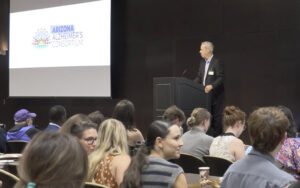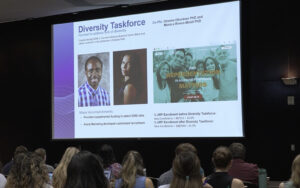- Slug: Alzheimer’s Consortium. 400 words.
- Photos available (thumbnails, captions below).
By Nicollette Valenzuela
Cronkite News
PHOENIX – Arizona is home to over 150,000 people aged 65 and older who live with Alzheimer’s, or 11% of older residents. Specialists are calling for more research to understand the higher prevalence of the disease among Hispanic Americans.
Alzheimer’s is a brain disease that alters the way a person thinks, behaves and remembers. Over time, the disorder slowly inhibits a person’s ability to perform everyday tasks.
Shannon Lindemer, senior psychometrist for the University of Arizona Nosotros Comprometidos a su Salud, says that these numbers are alarming, especially for the fastest-growing portion of the population.
“By the year 2060, it (Hispanic population) will … at least double in size,” Lindemer said. “Hispanics are about one and a half times more likely to be diagnosed with Alzheimer’s-dementia.”
Alzheimer’s is the most common form of dementia. In addition to a limited understanding of the disease and its causes, other barriers unique to the Hispanic population hinder the research. Low participation in trials is one of them, according to Joseph Saenz, a professor at Arizona State University’s Edson College of Nursing and Health Innovation.
“We don’t have enough Latinos in drug trials … we don’t have enough data on Latinos in general,” said Saenz.
Eric Reiman, executive director of Banner Alzheimer’s Institute of Arizona, said there is a lack of representation in research and a need to share it in plain terms.
“It is very common not to include individuals from underrepresented racial, ethnic, socioeconomic groups, and we need to find better ways to encourage them to participate in these studies so that we can learn what would be most informative for them,” Reiman said.
The two distinct categories of Latino and Hispanic are often used interchangeably, confusing data sets.
Oxford English Dictionary describes ethnicity as relating to cultural and traditional roots. In the U.S., ethnicity is broken into Hispanic and non-Hispanic, “differentiating those whose ancestors came from Spanish-speaking countries from those who did not.” Latinos are people from Latin America and can be divided into four major groups: Mexican, Central American, South American and Caribbean.
Nationally, Hispanics tend to live in clusters based on the country of origin. For example, Arizona has a large Mexican community, and New York is home to many Puerto Ricans and Dominicans.
The probability of acquiring Alzheimer’s disease and its symptoms is different for all the ethnicities encompassed by the terms Hispanic and Latino.
For more stories from Cronkite News, visit cronkitenews.azpbs.org.

